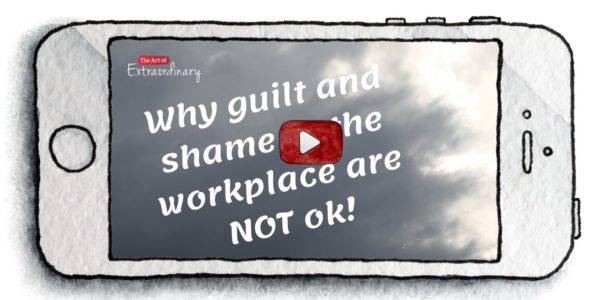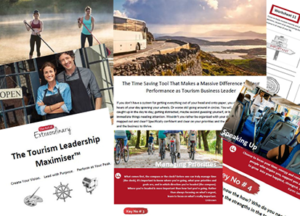Guilt and shame are ineffective, unproductive and absolutely have the reverse effect.
Rather than engaging and getting work done, they disengage teams, slows everybody down.
Now I would be the first to admit, as a leader, there have been times in my life where I have used those strategies. For leading from people, for getting an outcome. But you know what? Ultimately it actually doesn’t. It achieves nothing. In fact, in effect it’s really detrimental.
And right now, when teams need to be reconnected with each other, when they need to be reignited. We need passion reignited within every single workplace. And when realigning purpose and goals is essential right now, across the globe it’s really important to ask yourself:
“What are the ways in which I’m leading?
“And how effective are they?”
Guilt and shame are certainly not valid ones to be using, valid ways of treating people. And I want to talk about this because I’m really, really passionate about it.
Last night, on the side of the soccer field, I was told a story about a particular leader, using what I call a really immature style of leadership to get an outcome. In a room, where people weren’t listening and weren’t engaged, where they were talking. In the first instance, the leader used guilt to attempt to make them feel bad, then went on to use a particular strategy regularly naming and shaming with information on a whiteboard. He used these tactics as a way of trying to get what he wanted out of his people.
Now I guess let’s think about what is guilt exactly? It’s when, from a leadership perspective, it’s when you’re trying to get someone else to do something and by making them feel bad that they haven’t done it. Shame is a little bit of a more powerful emotion. I see that as an incredibly deep emotion.
Guilt is a little bit more about, “Well, what was the right thing? “What was the wrong thing?” And it’s not living up to certain standards. Where shame is a very, very deep and incredibly powerful emotion that people feel when they feel not accepted, not belonging, not loved, where criticism is provided rather than loving discipline. Or critique, great feedback that helps them grow and learn as a person. When we’re using shame as a technique to get an outcome, it’s really, it’s harsh. I want you to think about it in terms of, let’s say it’s a parent and a child. And delivering that critique that we do as parents.
We’ve all done it. Where we feel that we need to put the kids down in order to get an outcome. We want to put them down to diminish how they feel and ultimately it’s our ego. It’s our ego at play.
And in the workplace when our ego comes to the party and needs to rule, whether that’s with the thumps, think about it. Think about it, it’s that threatening hand.
It can really do a total disservice to the environment that you’re creating. Now perhaps that’s how you’ve been led in the past. And so you see that as a normal style of leadership. You might think that’s the only way to get the result that you want. You’ve perhaps tried giving it a go, but it didn’t work with using a more of an encouraging and a questioning style.
I really invite you to look at how you are leading and how that style is impacting team.
Because disengagement levels are really high. People are disengaged in the workplace. People have a very low motivation right now with everything going on.
The turbulence, the evolution, the agility required, the capacity.
Everyone’s feeling very stretched.
Or they’re feeling very disconnected because two-day weeks rather than a normal standard week is really unusual for people.
Or are people in the workplace and yet there are such high demands on what they can be doing? Their areas of business now have changed. Their area of skill required may have changed.
Here is how:
So I trust this is useful today. Please reach out if you you’d like some help.
1. Observation:
Please take some time firstly to reflect on it, well, start with the observation. Observe actually, “Is my ego at play here?” Is it really in the way in which I’m languaging, the words that I’m using, the tone of how I’m communicating? And remember that words and tone on email are as highly powerful as once you’re in a room.
When you’re in a room with someone and you can see people, if that’s on Microsoft Teams or if you’re using Zoom technology, your physiology will have a huge impact. And even more impactful is when there’s no communication, there’s no words. So silence is deafening. If you’re then coming back in with communication that’s really short, really sharp, that’s really expectational? You’ve got very high expectations and standards haven’t been realigned to get the team back together, to reconnect them. Even if it’s from week to week, month to month. Realigning those standards of how we function as a team, how we are as a great team, even when you’ve got a very varied level of capability and talent on the team. That is okay too.
What’s not okay is using this guilt and shame to put people down because they haven’t met your standards, or they haven’t done the job that you think they should be doing. We use so many “shoulds,” so please observe. Number one, observe your language, your style.
2. Reflection:
And then, two, do some reflection on it. “What can I be doing a little bit differently?” And think about then the ways that you’re communicating and what actually could you be doing slightly differently. Now this is recalibration. I like to think of it as just a fine tunement. What can we be tweaking? Little muscles are not everything.
3. Action:
And then the third piece is really important. Take action.
If you need help on the way in which you’re communicating, the style of leadership that you have. If you know it’s not necessarily working as well as it could be, and you want to see that engagement within your team improve. You want to see silos broken. A lot of teams right now are very siloed. People have been working very independently, very individually and if it’s time to reconnect that team, time to get them back onto the same page and realigned.
If you would like some help with your leadership style, and the way in which you’re communicating with people, please comment below and say, “LEADERSHIP STYLES”
Let’s get in touch and give you the tools that you need to really communicate in a great way, so that you can be very productive with your team. The team can be effective and build on performance.
Performance doesn’t happen overnight.
Talent isn’t developed overnight.
It is an ongoing work in progress that needs consistent touch points to help people learn, grow, develop and give feedback.
It’s a continual cycle of improvement.
Genevieve
P.S We have a useful resource called The Consistent Communication Scheduler, if you post COMMUNICATION below, I’ll get that to you straight away.




